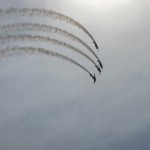
AIR SHOW REVIEW by Joey Cee
On the first day of the Canadian International Air Show, I weathered the CNE crowds and made my way to the VIP area along the Lakeshore to get a better view of what the show had to offer this year. And I was not disappointed. After checking out the flying machines a few days earlier at their landing and takeoff points at the airport, I had a better sense of what these pilots go through to entertain us in the air. Sitting in the cockpit of one the Harvard aircrafts I was surprised to find that the pilot’s only view is through a small rear view mirror on the side and from the side windows. They rely strictly on their instruments to know where they are going. I’m assuming that this goes for all the other aircraft. More of a reason to respect these high flying entertainers.
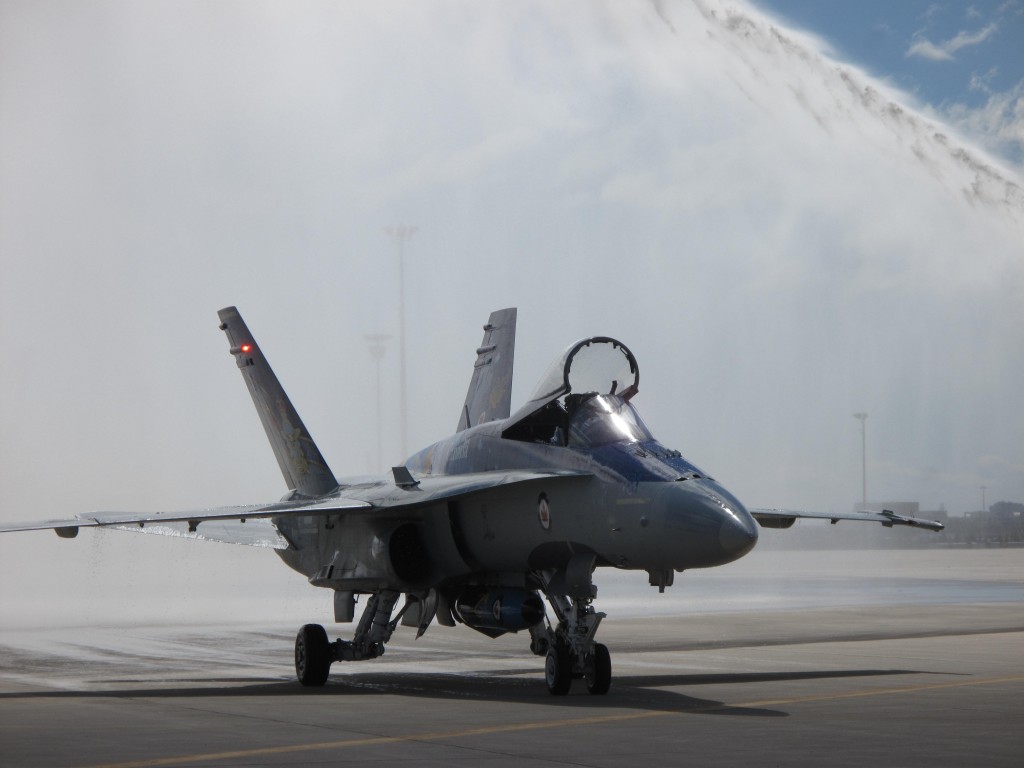
CF18 Hornet Lands with Water Salute at Pearson Airport
On the ground, I was in awe at the size of these birds and the effort they put into marking and decorating the exterior. Especially the CF18 Hornet.
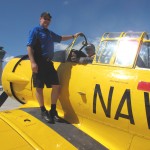
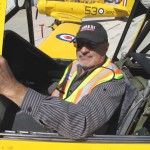
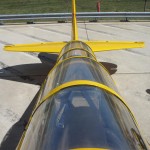
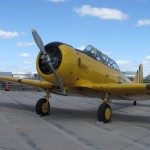
It is human nature to marvel at the wonders of flight. As children we watch birds soar as they fly above our heads. We look to the skies at the first sound of an aircraft. It matters little to us if it is a jet or a glider. It is the fascination of flight.
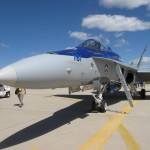
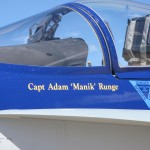
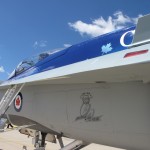
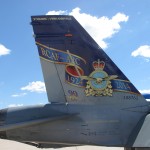
For 65 years, the Canadian International Air Show has been a source of awe and inspiration in satisfying the marvel of flight for millions of enthusiasts annually. The sounds of the past and present again transformed the skies over Toronto as with the 65th annual Canadian International Air Show along the shores of Lake Ontario.
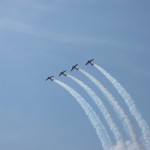
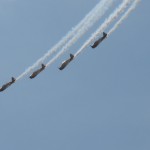
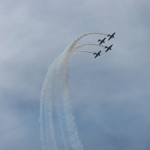
The show started off in loud and thundering fashion with the CF-18 HORNET ripping through the skies over Lake Ontario this Labour Day weekend! Showcasing the jet’s unbelievable maneuverability, combat capabilities and overall sky power, the Hornet fighter is always a crowd-favourite.
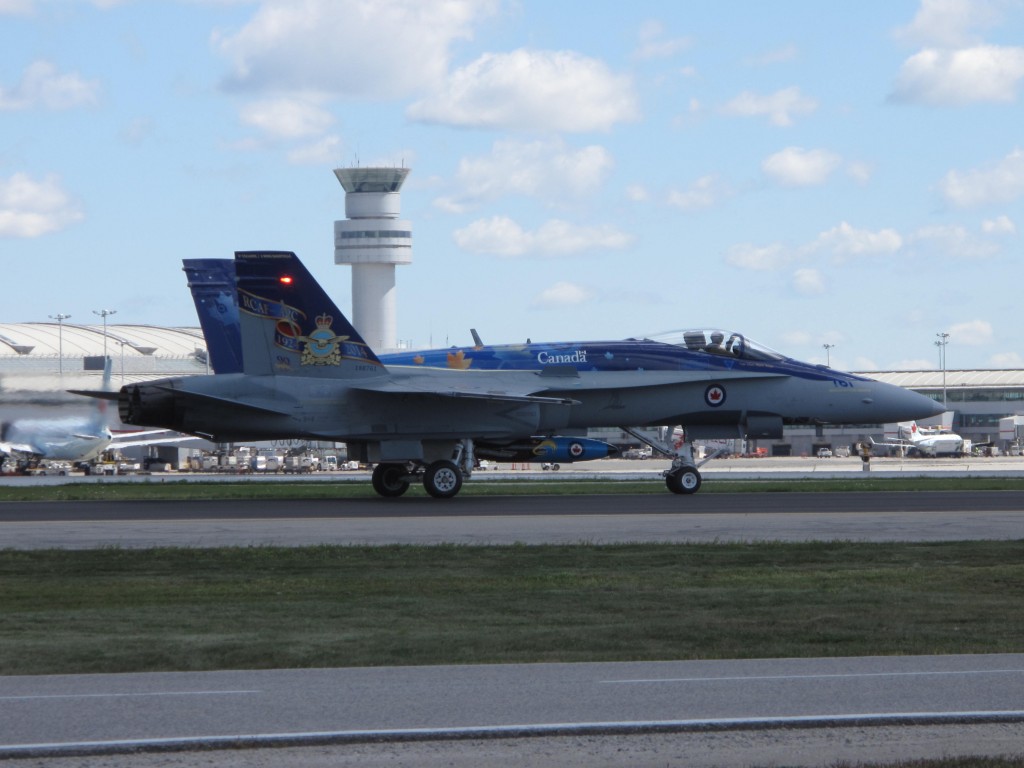
The C-123 Provider, known as the, ‘Thunder Pig,’ lives up to its name! Big and loud, this cargo aircraft is famous not only for its historical aviation background as a military heavy-lift airplane with STOL capabilities; it’s a Hollywood favourite, featured in box office hits CON AIR, Operation Dumbo Drop and Air America!
Sleek, loud and fast, Randy Ball’s MiG-17 left many breathless as they watched this beautiful short-nosed jet fly by. Its silver profile streaked across blue skies with its jet engine purring. A nimble fighter, the Mig is capable of flying at great speeds and maintaining up to 8gs and is the tightest-turning fighter of its time.
Mike Wiskus and the Lucas Oil Pitts Special operated by the civilian aerobatic flying team swooped, soared, dove, rolled and looped through the air while engaging the crowds below through direct contact over the PA system.
Since having flown at the CIAS during its inaugural display 65 years ago, the Harvard aircraft has smothered air show fans with smoke and noise many times since. Saluting the significant role of the aircraft in Canada’s aviation history, the Canadian Harvard Aerobatic Team – this year featuring a FOUR-SHIP AEROBATIC DEMO! toasted the 65th Anniversary of the CIAS with its awesome performance of radial engine muscle.
The unique blend of the Beech 18’s graceful fly-pasts and aerobatic routine make Matt Younkin’s display one of the most unusual on the air show circuit today. While the Beech 18 was never designed to perform Cuban 8s, point rolls and loops, Matt’s skilled flying – a legacy created by his famous father Bobby – revealed that this beautiful bird can do just that!
The Great War Flying Museum presented a fitting tribute honouring the 100th Anniversary of World War I; featuring four vintage aircraft in a simulated dog-fight over the Lake. The Fokker DRI Triplane, Sopwith 1 1/2 Strutter, RAF SE5a and Nieuport 28C takes you back to a time before advanced aviation technology and computer systems powered the skies.
The Lucas Oil Skydivers will jumped out over the water and soared down towards the crowd in an exquisite showing of high-energy skydiving expertise!
The T-33 ACEMAKER brought its wicked demo of jet thundering noise and speed to this year’s line-up as the highly-recognizable silhouette of this super-fast fighting bird raced down the show-line.
This year, the Commemorative Air Force’s Mustang flew in tribute to the Tuskegee Airmen of the infamous Red Tail Squadron – the subject of a recent award winning film starring Cuba Gooding Jr. A spectacular warbird of years’ past, the P-51 MUSTANG is a favourite of many vintage aviation enthusiasts.
Quiet and tame, The Bellanca Scout Tow-Plane and Schweizer 2-33 Glider, used in cadet flight training, did a couple of fly bys under the command of the Royal Canadian Air Cadet League. This is the largest youth organization which has inspired thousands of Canadian pilots to get their wings, including our national Astronaut hero, Commander Chris Hadfield.
Lee Barker’s ANTONOV AN-2 showcased the world’s biggest single-engine bi-plane. Still produced today, the Antonov AN-2’s radial engine and super-sized wingspan make it the perfect bush plane – so much so, that it was produced by the thousands. Built with incredible STOL capabilities, the AN-2 was a delight to see flying.
The final touch, and the long-awaited show favourites did not disappoint and provided a seemingly long program. Canada’s icons of the air, the CF Snowbirds brought on the wow factor with their high-speed aerial performance of formation feats and incredible aerobatic artistry. Much loved by Canadians and beyond, the Snowbirds celebrate the 90th Anniversary of the Royal Canadian Air Force at the 2014 Canadian International Air Show.
THE SATURDAY SHOW featured:
Lucas Jumpers/Wiskus Pitts
CF-18 Hornet Demo
Younkin – Twin Beech
Mike Wiskus/Lucas Pitts
T-33 Acemaker
Canadian Harvards Aeros
MiG-17F
Great War Museum
Antonov AN-2
Cadets
P-51 Re dtail
C-123 “Thunderpig”
Snowbirds
Report and Photos by Joey Cee
FACTS YOU SHOULD KNOW WHEN YOU SEE THE AIR SHOW!
Canadian International Air Show
Celebrating 65 Years with
65 Fun, Fantastic Facts & Aviation History
- Canada’s largest and longest-running air show.
- The 3rd largest air show in North America.
- Over 1.4 million people watch the air show annually from Exhibition Place, Ontario Place and east & west of the grounds.
- In 1948, the air show was held at Malton Airport under the sponsorship of the Toronto Flying Club. The Globe and Mail reported “over 80,000 people stormed the airport”.
- In 1949, the one-day air show moved to Exhibition Park and was re-named the National Air Show.
- In 1950, four Harvards performed daily firing three-inch rockets carrying 25 pound concrete practice heads at a brightly-coloured target anchored off the waterfront.
- Visitors heard their first sonic boom in 1952 when an RCAF F-86 Sabre broke the sound barrier on its second pass.
- In 1953, the National Air show produced by the Toronto Flying Club and scheduled for September 19th was getting international recognition. The Globe & Mail reported that ‘in its short career it has come to be ranked the fifth largest of such events in the world, surpassed only in Britain, the United States, Russia and France, all of them many times more populous than our own country’.
- The 1953, the air show had high profile visiting dignitaries. They were war heroes Lord Tedder, Marshal of the Royal Air Force whose bombing tactics during WWII became known as the “Tedder Carpet”, USAF General Hoyt S. Vandenberg, second Chief of Staff, and second Director of Central Intelligence and Igor Sikorsky, Russian American aviation pioneer in both helicopters and fixed-wing aircraft.
- The Avro Jetliner made its final public appearance at the 1954 show.
- The air show became the Canadian International Air Show (CIAS) in 1955, however the show scheduled for Sunday, June 3rd was barred. The Lord’s Day Act empowered municipalities to legalize public games or sports on Sunday but did not include ‘performances’ such as an air show.
- Russian representatives attended the Saturday show for the first time in 1955 to see supersonic jet fighters flown by Canadian and U.S. air forces. They reportedly sat ‘stoney-faced’ except when three USAF F-86D Sabres flew low and fired their after-burners with a ‘thundering crash’ directly over the official stand.
- In 1956, the CIAS was extended to two days when it officially became part of the CNE, taking place the last two days of the Fair.
- The U.S. Navy Blue Angels appeared for the first time in 1956 flying 4 Grumman F-9F’s.
- The Royal Canadian Navy VF 870 Aerobatic Team with 6 Banshees appeared in each of the 2 days in 1956.
- The U.S. Air Force Thunderbirds first appeared in 1957 flying the F-100 Super Sabre.
- The Avro Arrow 25202 was standing by for its public debut on Saturday, September 6th 1958 but was cancelled due to adverse weather.
- 1959 marked the 10th Anniversary of the show and the RCAF Golden Hawks appeared in F-86 Sabres to celebrate the 50th Anniversary of Powered Flight in Canada. The team last appeared in 1963.
- From 1960 to 1963, 38 T-33 Silver Stars spelled out the letters ‘R C A F’ in a massive aerial formation.
- There has been at least one parachute team in every show from 1962 to 1998.
- In 1963, one of the RCAF T-33 Red Knight demo pilots was Wayne MacLellan who became a volunteer in 1977 and went on to become Air Director, Board member and Chairman of the Board of Directors.
- In 1969, on the show’s 20th Anniversary, the CIAS became a four-day event and ran Friday, Saturday, Sunday and Monday of Labour Day weekend.
- The Canadian Forces Snowbirds aerobatic team first performed in 1972 and have been part of the CIAS ever since – the Snowbirds have appeared more times than any other act!
- The first appearance of the Royal Air Force Harrier was in 1972.
- Aerobatic pilot Art Scholl, who later filmed flying segments in the movie ‘Top Gun’, performed night displays in 1974 and 1975.
- The U.S. Marine Corps Harrier first appeared in 1977.
- 1979 marked the 30th Anniversary of the show and the British Airways Concorde became a featured attraction from 1979 to 1988.
- In 1981, the Canadian Forces Dragonflies display team, flying brightly-painted Kiowa helicopters, flew 2 shows at the CIAS and did a team formation photo shoot around the CN Tower.
- The CF-18 made its first demo appearance in 1983 and has been a frequent and popular performer ever since.
- The Bobcats CF-101 Voodoo team last appeared in 1984 when the interceptor aircraft retired.
- 1986 was a banner year featuring 3 jet teams: the Snowbirds, the USAF Thunderbirds and the one and only appearance of the Italian Air Force Frecce Tricolori – the appearance of the 10 plane Italian team, with its spectacular red, white & green smoke trails over downtown Toronto, brought parts of the city to a stand-still.
- The Honourable Lincoln Alexander, Lieutenant Governor of Ontario, was named Honorary Patron to the show in 1988, 1989 and 1990.
- In 1989, on the 40th Anniversary of the show, the CIAS became a 3-day event.
- 1990 was the first and only time the Air Canada A320 flew at the CIAS with one of our very own volunteers, Jim Peirce, as pilot.
- 1992 was highlighted by both daytime and nighttime performances, with pyrotechnics, featuring aerobatic champion Sean D. Tucker in his Pitts S-25.
- In 1993, a Photo Walking Tour took place at Pearson International Airport.
- In 1995, the Walking Tour expanded to include a Flight Centre in the Air Canada hangar complete with a photo contest AND the first ever Flight Deck site at the CNE waterfront.
- 1996 saw the first female Director, Debbie Day, elected to the Board of Directors.
- The 1996 and 1997 shows featured a static display with Flight Line Walking Tours at the former Wardair hangar.
- In 1997, the USAF B-2 ‘Spirit’ Stealth Bomber made its first appearance at the CIAS.
- In 1998, Canadian astronaut Dr. Dave Williams carried a CIAS patch onboard his space shuttle flight Columbia.
- In 1998, Donna Cansfield was elected the first female Chair of the Board of Directors, a position she held until 2002.
- In 1999, HRH Prince Andrew, Duke of York, CVO, ADC was named Honorary Patron; a former pilot with the Royal Air Force, he flew helicopters in the Falklands War.
- In 1999, Canada Post issued a commemorative stamp in honour of the 50th Anniversary of the CIAS.
- On August 20th 1999, a CIAS 50th Anniversary commemorative plaque was unveiled by The Ontario Heritage Foundation, currently placed on the north side of the Bailey Bridge within the CNE grounds.
- In 2000, ‘Bruce the Moose’ flew over the show site dangling from a helicopter as part of Toronto’s “Moose in the City” promotion.
- 2001 is the only year the CIAS included a twilight show with military aircraft featuring the USAF Thunderbirds.
- In 2002, the Royal Air Force Red Arrows made their only appearance dazzling visitors with red and white smoke trails.
- In 2006, the USAF F-22 Raptor made its first appearance outside of the U.S. without landing in Toronto.
- In 2007, the USAF F-22 Raptor landed in Toronto marking its first time on foreign soil; the first Canadian civilian to see the cockpit of the Raptor when it landed was CIAS volunteer Andy Armstrong, a YYZ firefighter.
- The first female CIAS President, Patricia (Roberts) Volker, was elected in 2008 and served until October 2010.
- In 2009, the 60th Anniversary of the CIAS also marked the 100th anniversary of powered flight in Canada and the 80th anniversary of the Port George IV (now Billy Bishop) Island Airport.
- Lt-Col. Maryse Carmichael, first female Snowbird pilot and first female Commanding Officer of the Snowbird squadron, officially opened the 2010 air show to celebrate the Centennials of the Canadian Navy and Women in Aviation.
- The CIAS is not all aircraft: in 2010 HMCS Fredericton and in 2011 HMCS Shawinigan did a sail-past and fired their guns in a salute to the Royal Canadian Navy.
- The 2011 show included the first appearance of the U.S. Marine Corps V-22 Osprey.
- Astronaut Col. Chris Hadfield, the first Canadian to walk in space and also to command the International Space Station, opened the 2013 air show.
- 2013 marked the first time there were no U.S. military performers at the CIAS due to U.S. sequestration.
- The only privately owned AV-8B Harrier in the world performed in 2013.
- The first full-time paid employee was hired in 1982; currently there are only 2 full time paid staff working on the CIAS year round with one additional summer person.
- Approximately 200 volunteers work on the air show year round and over Labour Day weekend, including generations of families with both parents and children.
- The longest serving volunteer with the CIAS is Gord Battaglia. The former Air Canada employee has served for over 60 years, first with Airport Operations and now with the Membership Committee.
- In 2014, over 35% of CIAS volunteers have been with the show for more than 15 years, 25% over 20 years and 8% over 30 years; 36% of the volunteers are women.
- There are a number of different committees within the organization including administration, air operations, airport operations, community relations, emergency response, hospitality, hotel operations, membership, merchandising, photography, protocol, public affairs/media, security, sponsorship, telecommunications, transportation, waterfront operations, web design/multi-media, as well as a Board of Directors.
- The CIAS Alumni includes over 130 members who are no longer active but continue to be recognized and honoured for their years of service.
- The CIAS can sign student volunteer requirement forms for High School Community Involvement Activities to anyone wishing to help the organization.
THE REST IS HISTORY IN THE MAKING!








